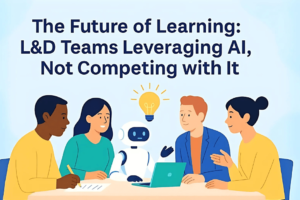
AI’s Impact on Workforce: Emphasizing Skills Over Roles
Skills, Gig Economy, Training, Learning, Employee Onboarding, Job Role, Workforce Development, and AI-these are not just random words.
They are interconnected elements that shape the future of our workforce.
What do these seemingly disparate elements have in common?
How do they intersect in the context of AI and workforce development?
What if we added corporate learning, enterprise, large enterprise, mid-market, small business, associations, organizations, and so forth?
What if we start to realize and recognize that the current approach to online learning, as applicable to the above, is no longer going to be in play?
Finally, what if we realize that your company, entirely dedicated to AI, is so focused on the revenue standpoint and productivity that it is missing the bigger picture and what comes with that – all the warts.
Who feels the impact?
Entry jobs
Who are these folks?
Your recent grads, internships, and folks who want to join your company from scratch, even with a few years of experience under their belt, might be looking to switch roles.
- Coders – This is already happening. We are not just talking about entry-level positions; it includes experienced professionals.
- Customer Service – Unless it is face to face, anything can be handled by AI. That said, initial data on AI handling calls tied to customer service and support over the phone reveals that people (those calling in or via text chat) strongly dislike it. I can attest to the latter. Those chatbots where you ask questions around help on how to do something, or that you need to talk to sales or a customer rep, are beyond awful. It gets frustrating quickly. And it turns off clients.
- HR related – You already see it with recruiting and folks interviewing first or second stage. Unless the state (here in the U.S.) requires that the company offer the option of an actual human reading the job application and responding (NY has it on its books already, and it is in place), then why do I need you for that within your role? More importantly, why do we need the resources?
- Sales – It is both a crux and offers an opportunity with AI to streamline and help. However, people are submitting requests to see the system or learn more. AI can handle that. If you need to make cold calls (in this day and age, a bad idea) – AI can handle that.
What is happening around AI and job roles?
This is where insight into the impact enters the potentially brutal stage.
- Anything that an automation workflow can handle impacts the white-collar job role, and the automation uses AI.
- Content marketing plus other marketing areas. If you are a website builder, that is going by the wayside. Content marketing, as noted earlier – see ya. Creating marketing campaigns? AI doable.
- Teachers – Yes, I agree it is unfathomable to think this way – long-term though, and again, it is starting to be seen – schools using AI for everything with online learning
The problem with this, and it’s being lost on schools that are doing this, is that students will think AI is 100% accurate.
The all-in-one school believes AI is 100% correct.
What happens – and it will – when it hallucinates or shows bias?
Because, get ready here – it will.
The most significant area that will take the hit will be the tech sector.
Think about that for a second.
The people and companies that have adopted AI, along with junior engineers involved in AI development and similar roles, are they inadvertently jeopardizing their job security in the future?
It reminds me of people who are going to lose their jobs having to train the person who is replacing them.
Many people in the workforce have experienced this gut-wrenching approach.
Yes, I’ve written in the past the number of jobs that will be lost due to AI, which, in turn, I hear from people saying that I am wrong – well, take a look at the numbers and what others are saying.
Again, we are at an infant stage.
What roles are safe for now?
Blue-collar.
This is where things get a bit tricky. If you work in a warehouse, taking orders and completing paperwork, it’s replaceable by AI.
Pick and pack – if you’re using an ERP to handle that, that person is replaceable.
However, if it is on-site and someone is grabbing the boxes and fulfilling them, then it’s safe – I’m not going into the whole robot angle.
We need to propose a new way for learning and training for employees.
The old ways are no longer sufficient in the face of AI’s rapid advancement.
This idea isn’t a new one; others have presented it in various ways.
Skills First
I read through a discussion about skill-driven rather than job-role-driven approaches.
They examined it from the gig economy perspective at your business.
Because we are in the e-learning side of the house (aka online learning), and learning technology – which includes all types of learning systems, including talent development – I thought about how this can play directly for those end-users (employees in this case, or association members and similar as mentioned way at the top).
Some systems use the “opportunities” aspect.
What they do, though, and if you think about it, is all around job roles.
You want role A?
Okay, I see you have these skills, but you need to learn these skills – and here is the content tied to it.
Are you in this job role?
Okay, here are the skills you need to learn for the role.
Everything is a job role.
Onboarding for job role C?
Okay, take this content, which is assigned to you, for that role.
Tapping into the gig economy turns it upside down – and I believe in a good way, because it recognizes that, as the CEO of Nvidia stated, everything will be affected by AI.
I’m not referencing today, nor was the Nvidia CEO, but long-term.
Okay, Craig, explain the skills drive and not the job role?
The best way to explain it is to look at it from the perspective of a project.
Real World Example
Have you ever been assigned a project?
Or is your job role tied to that specific project?
Did you have the skills expected for that project, or were you tossed in because of your job role?
It was tied to your job role.
What if, though, you wanted to be on that project, but it was because your skills were the reason for doing so, not the job role you have?
How many companies, specifically departments, would say, “Okay, William, I see that you work in Accounting, but you do have the skills that we need for this project, so let’s bring you on.”
If the project didn’t involve accounting and had nothing to do with accounting, then the probability that William gets to be in the project is ZERO, even though he has all the skills needed to do so. Upon reviewing the project team, you recognize that William would be a strong fit and of great value.
A gig approach within the company prioritizes skills over job roles.
What is the outlay here?
An employee who becomes invaluable to your company and your department.
Continuous learning.
When AI comes for that job role, it won’t apply.
That employee, with the skills that drive whatever is needed, is reskilled for it.
Reskilling, as I mention frequently, plays a significant role here.
On the blue-collar side, those jobs are not impacted as a whole compared to the white-collar side.
Skills-first will enhance onboarding, demonstrate the ROI or IOL for Training, or help those in L&D, whereas the company aims to understand why they need you or that department.
How do I start the process?
For learning tech companies (again, learning systems are in there), flip it around.
Rather than pushing job roles, prioritize skills, skills, skills.
How many gigs exist at the company today that can be leveraged as skills-first opportunities?
L&D and Training should develop a business plan and processes for its development, and then implement it.
It will require buy-in, and by utilizing learning tech to make it adaptable in the short and long term, it involves finding a vendor who is willing to assist in that fashion.
They have to see the value, rather than just saying it.
They have to show it.
Bottom Line
This gig skills-first is not easy.
It involves Change.
A scary word.
For all of us.
E-Learning 24/7
Source link



